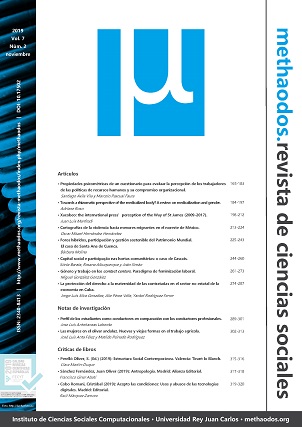Xacobeo: the international press’ perception of the Way of St James (2009-2017)
Main Article Content
Abstract
This work studies the international press’s perception of the Way of St James in 111,968 articles published in 21 languages during the period 2009-2017. The study performed here on what has been identified as a place branding activity with the collaboration of the public and private sectors is based on three hypotheses: 1) the international press coverage of the Way of St James is seasonal, i.e. directly related to a rise in summer visitor numbers; 2) the Way is a relevant asset in the construction of the image of Spain as an international tourist destination as regards culture, religion, and art; and 3) the Xacobeo brand is recognised and well-placed in the reference press. As to the first assumption, it has been observed that an increase in international press coverage of the Way –generally positive – does indeed coincide with a rise in the number of pilgrims during the summer months, and when this coverage continues in the following months it boosts visitor numbers. The second assumption has also been confirmed. But as regards the Xacobeo brand its perception leaves a lot of be desired: it seems the great managerial challenge to boost tourism in the next years.
Downloads
Article Details
References
Amaro, S., Antunes, A. and Henriques, C. (2018): “A closer look at Santiago de Compostela’s pilgrims through the lens of motivations”, Tourism Management, 64: 271-280. https://doi.org/10.1016/j.tourman.2017.09.007
Andrade Suárez, M. J. and Caamaño Franco, I. (2016): “La imagen del Camino de Santiago: Análisis de su representación promocional como producto turístico”, Tourism & Management Studies, 12 (2): 38-46. https://doi.org/10.18089/tms.2016.12205
Aziz, N. (2016): “Universities as stakeholders that influence students’ intention to visit a place”, Place Branding and Public Diplomacy, 12 (4): 249-267. https://doi.org/10.1057/s41254-016-0005-y
Bambi, G. and Barbari, M. eds. (2014). The European Pilgrimage Routes for promoting sustainable and quality tourism in rural areas. Florence: Firenze University Press.
Caldwell, N. and Freire, J. R. (2004): “The Differences Between Branding a Country, a Region and a City: Applying the Brand Box Model”, Brand Management, 12 (1): 50-61. https://doi.org/10.1057/palgrave.bm.2540201
Cerda-Bertomeu, M. J. and Sarabia-Sanchez, F. J. (2016): “Stakeholders’ perceptions of place branding and the role of the public sector: an exploratory analysis”, Place Branding and Public Diplomacy, 12 (4): 299-313. https://doi.org/10.1057/s41254-016-0016-8
Choi, S. and Cai, L. A. (2016): “Dimensionality and associations of country and destination images and visitor intention”, Place Branding and Public Diplomacy, 12 (4): 268-284. https://doi.org/10.1057/s41254-016-0004-z
Del Fresno, M., Daly, A. J. and Segado, S. (2016): “Identifying the new Influences in the Internet Era: Social Media and Social Network Analysis”, Revista Española de Investigaciones Sociológicas, 153: 23-42. https://doi.org/10.5477/cis/reis.153.23
Della Dora, V. (2011): “Engaging sacred space: Experiments in the field”, Journal of Geography in Higher Education, 35: 163–184. http://dx.doi.org/10.1080/03098265.2010.523682
Eshuis, J. and Klijn, E. H. (2012): Branding in Governance and Public Management. London: Routledge.
Gnoth, J. (2007): “The Structure of Destination Brands: Leveraging Values”, Tourism Analysis, 12 (5-6): 345-358. https://doi.org/10.3727/108354207783227939
Himelboim, I., McCreery, S. and Smith, M. (2013): “Birds of a feather tweet together: integrating network and content analyses to examine cross-ideology exposure on Twitter”, Journal of Computer-Mediated Communication, 18 (2): 40-60. https://doi.org/10.1111/jcc4.12001
Kavaratzis, M. (2015): “Place branding scholars and practitioners: ‘strangers in the night’?”, Journal of Place Management and Development 8 (3): 266-270. https://doi.org/10.1108/jpmd-10-2015-0049
Kavaratzis, M., Warnaby, G. and Ashworth, G. J. eds. (2015): Rethinking place branding: Comprehensive brand development for cities and regions. Cham: Springer International Publishing. https://doi.org/10.1108/jpmd-06-2015-0015
Lois Gonzalez, R. C., Castro Fernández, B. and Lopez, L. (2016): “From sacred place to monumental space: The mobility along the way to St. James”, Mobilities, 11 (5): 770-788. https://doi.org/10.1080/17450101.2015.1080528
Lopez, L., Lois González, R. and Castro Fernández, B. (2017): “Spiritual tourism on the way of Saint James the current situation”, Tourism Management Perspectives, 24: 225-234. https://doi.org/10.1016/j.tmp.2017.07.015
Lucarelli, A. and Berg, P. O. (2011): “City branding: a state‐of‐the‐art review of the research domain”, Journal of Place Management and Development, 4 (1): 9-27. https://doi.org/10.1108/17538331111117133
Macnamara, J. (2014): “Journalism-PR relations revisited: the good news, the bad news, and insights into tomorrow’s news”, Public Relations Review, 40 (5): 739-750. https://doi.org/10.1016/j.pubrev.2014.07.002
Moilanen, T. (2015): “Challenges of city branding: A comparative study of 10 European cities”, Place Branding and Public Diplomacy, 11 (3): 216-225. https://doi.org/10.1057/pb.2015.6
— and Rainisto, S. (2009): How to brand nations, cities and destinations. A planning book for place branding. London: Palgrave MacMillan.
Moore, M. H. (1998): Creating Public Value. Strategic Management in Government. Cambridge: Harvard University Press.
Peighambari, K., Sattari, S., Foster, T. and Wallström, A. (2016): “Two tales of one city: Image versus identity”, Place Branding and Public Diplomacy, 12 (4): 14-328. https://doi.org/10.1057/pb.2015.25
Sarabia-Sanchez, F. J. and Cerda-Bertomeu, M. J. (2017): “Place brand developers’ perceptions of brand identity, brand arquitecture and neutrality in place brand development”, Place Branding and Public Diplomacy, 13 (1): 51-64. https://doi.org/10.1057/s41254-016-0017-7
Tilson, D. J. (2005): “Religious-spiritual tourism and promotional campaign: A church state partnership for St. James and Spain”, Journal of Hospitality, Marketing & Management, 12 (1): 9-40. https://doi.org/10.1300/j150v12n01_03
Turespaña (2015). “En el patrimonio de la humanidad en el camino de Santiago”. Available in: http://www.spain.info/es/reportajes/patrimonio_humanidad_camino_santiago.html
Wang, J. (2006): “Localising public diplomacy: The role of sub-national actors in nation branding”, Place Branding, 2 (1): 32-42. https://doi.org/10.1057/palgrave.pb.5990043
Zenker, S. and Braun, E. (2010): “Branding a city: a conceptual approach for place branding and place brand management”, in Beckmann, S. C. ed.: Proceedings of the Thirty-ninth European Marketing Academy Conference; EMAC 39th Conference. 1-4 June, Copenhagen, Denmark. Copenhagen: European Marketing Academy.

